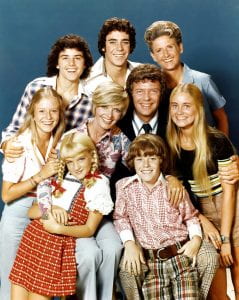Eisenstock, Barbara A. Television as a Source of Career Awareness for Children: Effects of Sex and Sex Role Preferences, University of Southern California, Ann Arbor, 1979. ProQuest, http://prx.library.gatech.edu
Eisenstock’s paper above goes into talks about the discovery of career and career options by children, and the various factors that go into this discovery, as told from a professional research angle (graduate school). Eisenstock focuses on TV as a career discovery tool for children, in part due to its accessibility to anyone. Eisenstock references the common trend for TV of the time (1979) to place women in low-status occupations, such as secretaries and homemakers, and for men to be placed in high-status occupations such as doctors or lawyers. Eisenstock states that the continuation of these traditional sex-roles may be a major factor in the slow acceptance of non-traditional occupations and sex-roles. Eisenstock found that a child’s knowledge of his or her sex role mitigated the effect of traditional TV and that feminine and androgynous identified children reacted much better to the non-traditional work role sexes on TV than the masculine identified children. The idea that TV can both bring down and uplift society through its portrayal of gender is a good starting point for my group’s discussion.
Foust, James C., and Katherine A. Bradshaw. “Something for the Boys: Framing Images of Women in Broadcasting Magazine in the 1950s.” Journalism History, vol. 33, no. 2, 2007, pp. 93-95,97-100. ProQuest, http://prx.library.gatech.edu
In the paper above, Foust and Katherine analyze the presence of women in Broadcasting magazine, a trade magazine associated with the broadcasting and TV industry, and determining in what light women are portrayed. They found that there are four major portrayals of the women in the magazines: women as sex objects or decoration, women as housewives, women displaying stereotypical behaviors, and women as professionals. The positive portrayals of women as professionals was found the be heavily outweighed by the other portrayals, 85 percent as opposed to 12 percent. One prominent example was the “Something for the Boys” section of an edition that only portrayed female models for a two-page spread. This research was done using a random sampling method and coding to analyze the frames of 1950s decade issues. This portrayal of women in Broadcasting publications could have been another reason why women in professional broadcasting roles were very rare in the early years of TV in addition to the already high barrier to entry for women in a male dominated industry.
Hoffner, Cynthia, and Martha Buchanan. “Young Adults’ Wishful Identification with Television Characters: The Role of Perceived Similarity and Character Attributes.” Media Psychology, vol. 7, no. 4, 2005, pp. 325-351. ProQuest, http://prx.library.gatech.edu
The above paper tried to answer the question of the factors that go into the perceptions of young adults’ wishful identification, that is the desire to be like or act like a character. They organized a list of perceived character attributes (smart, successful, attractive, funny, violent, and admired) and determined the most wishfully identified with character traits. They found that males tended to want to be like male characters that they perceived as successful, intelligent, and violent, whereas women identified with female characters that were perceived as successful, intelligent, attractive, and admired. The above research helps to determine a difference between older audiences preferred traits and the genders that preferred them. The knowledge that women liked attractive and admired characters versus men liking more violent characters can help to focus in my thoughts on what to look for in a sample of children’s TV shows’ gendered characters; violence in male characters and attractiveness and admiration for female characters.
Liben, Lynn S., and Rebecca S. Bigler. “The Developmental Course of Gender Differentiation: Conceptualizing, Measuring, and Evaluating Constructs and Pathways.” Monographs of the Society for Research in Child Development, vol. 67, no. 2, 2002, pp. 1-147. ProQuest, http://prx.library.gatech.edu
Liben and Rebecca set out to determine how exactly gender differentiation unfolds to stop a classic situation of gender stereotyping possibly limiting individual expression. They state that gender differentiation might come about from consumption of general ideas about specific concepts (toys, jobs, etc.) and then be applied to other various aspects (including themselves). They then also say that the same process can happen, but the child instead focuses on themselves to determine their ideas. This could be shown simply through two scenarios, one where a male child likes a toy, and using their identity, they identify that toy as male toy, and another where a male child identifies that toy as male, and then plays with it, identifying himself as a male. This understanding of some possible gender differentiation ideas can help to understand to what extent TV and culture has on gender and gender identity, serving a purpose for my research and developing my understanding.
Miller, M. M., and Byron Reeves. “Dramatic TV Content and Children’s Sex Role Stereotypes.” Journal of Broadcasting, vol. 20, no. 1, 1976, pp. 35-50. ProQuest, http://prx.library.gatech.edu/login?url=https://search.proquest.com/docview/60878348?accountid=11107.
In the above paper, Miller and Byron asked the question of whether the portrayal of women in TV in non-traditional occupations would make a child (3rd – 6th grade) say that the non-stereotypical role was fitting for women. The findings showed that in 5 out of 6 cases, children who were exposed to non-stereotypical in TV would say that the role seen was fitting for girls. They found that, in general, TV causes sex-role stereotyping in children, but this could be reversed, and TV could become a factor in helping society break down these sex-role stereotypes. This study helps to further back the main idea that children’s TV can and will affect their view on other people and genders. (and the roles associated with them) The further backing helps to both strengthen the argument of this paper, but also strengthen the argument of any other papers that dealt with TV and children’s thoughts on gender roles.
Pila, Sarah C. The “Good Girls”: Exploring Features of Female Characters in Children’s Animated Television, Tufts University, Ann Arbor, 2015. ProQuest, http://prx.library.gatech.edu
Sarah begins the paper by stating a goal of determining how animated children’s (ages 6 – 12) cartoons portray women in general. Sarah mentions that there could be possible unknown effects of children being exposed to cartoons that portray women in a specific way. Generally, Sarah found that animated TV portrays twice as many male characters when compared to female characters, and that female conversations are more stereotypical in educational TV. Sarah’s extensive usage of other research and relating to the social cognitive theory of children’s development helps to ground and explain her thought processes clearly. Sarah states that her findings are that women are portrayed less and that they tend to be portrayed as more youthful and ‘attractive’ than the male characters. If we accept that children practice social learning, this may lead us to understand why children tend to simply fall into the gender dichotomy that is classically portrayed, girl actions and boy actions, and no mingling of the two.









